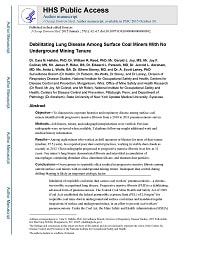Mining Publication: Debilitating Lung Disease Among Surface Coal Miners with No Underground Mining Tenure
Original creation date: January 2015
Authors: CN Halldin, WR Reed, G Joy, JF Colinet, JP Rider, EL Petsonk, JL Abraham, AL Wolfe, E Storey, AS Laney
Objective
To characterize exposure histories and respiratory disease among surface coal miners identified with progressive massive fibrosis from a 2010 to 2011 pneumoconiosis survey.
Methods
Job history, tenure, and radiograph interpretations were verified. Previous radiographs were reviewed when available. Telephone follow-up sought additional work and medical history information.
Results
Among eight miners who worked as drill operators or blasters for most of their tenure (median, 35.5 years), two reported poor dust control practices, working in visible dust clouds as recently as 2012. Chest radiographs progressed to progressive massive fibrosis in as few as 11 years. One miner’s lung biopsy demonstrated fibrosis and interstitial accumulation of macrophages containing abundant silica, aluminum silicate, and titanium dust particles.
Conclusions
Overexposure to respirable silica resulted in progressive massive fibrosis among current surface coal miners with no underground mining tenure. Inadequate dust control during drilling/blasting is likely an important etiologic factor.

- Control of Respirable Dust
- The Impact of Black Lung and a Methodology for Controlling Respirable Dust
- NIOSH Hazard Controls 27 - New Shroud Design Controls Silica Dust from Surface Mine and Construction Blast Hole Drills
- Respirable Dust
- Respirable Dust Control for Surface Mines
- Respiratory Diseases
- Suggestion of a Cause-and-Effect Relationship Among Coal Rank, Airborne Dust, and Incidence of Workers' Pneumoconiosis
- Technology News 440 - Improved Dust Control for Surface Coal Mine Drills With Rotoclone Collectors
- Technology News 447 - Dust Collector Discharge Shroud Reduces Dust Exposure to Drill Operators at Surface Coal Mines
- Trend in Black Lung Cases Concerns NIOSH Researchers